A whopping 60% of business leaders plan to increase their spending on marketing automation in the coming year.
With the highest percentage (63%) of marketers using automation for email marketing, no wonder email automation will continue to grow in importance and impact.
An email drip campaign, one of the more effective forms of email marketing automation, is vital to every business’s marketing strategy.
In this blog post, you’ll find everything you need to know about email drip campaigns, including drip campaign examples and ways to develop an effective drip campaign strategy that works. Email analytics tools can provide significant assistance in this regard, as they are software applications designed to help you monitor and assess the effectiveness of your email campaigns.
Let’s start learning how to make your email campaigns more profitable, shall we?
What is an Email Drip Campaign?
An email drip campaign (an ‘email drip’ in short) is a series of automated emails sent to new subscribers or existing customers based on predetermined triggers and user actions.
How different are drip emails from email automation? An email automation is an email sequence comprising one or more fully automated emails. Drip email campaigns are a specific email automation type that usually involves multiple emails.
Benefits of Drip Marketing Campaigns
A drip marketing campaign brings the following key benefits to businesses:
- Increases sales and revenue from both current and new customers;
- Nurtures prospects through targeted messaging at scale;
- Enhances the buyer’s journey to better customer experience;
- Facilitates timely & relevant communication;
- Optimizes the sales funnel for higher conversions;
- Promotes customer loyalty & retention;
- Enables customized yet scalable customer experiences.
Besides enhancing customer relationships through responsive messaging, drip campaign emails provide better overall returns on investment (ROI) for your email marketing efforts.
Types of Email Drip Campaigns
Whether you’re looking to grow your sales pipeline by running lead nurturing campaigns or planning to boost sales by setting up sales promotions, drip campaigns have an answer for everything.
Following are the most common types of drip marketing campaigns and the ways that you can use them for maximum effectiveness:
1. Welcome Emails Sequence
A welcome email series is an automated drip sequence sent to fresh signups or new customers.
Get your readers acquainted with your brand, share helpful resources, and make them feel like an integral part of your online community.
Take a look at Lyft’s welcome email that showcases its stunning on-brand design and explains how to make the most of the app.
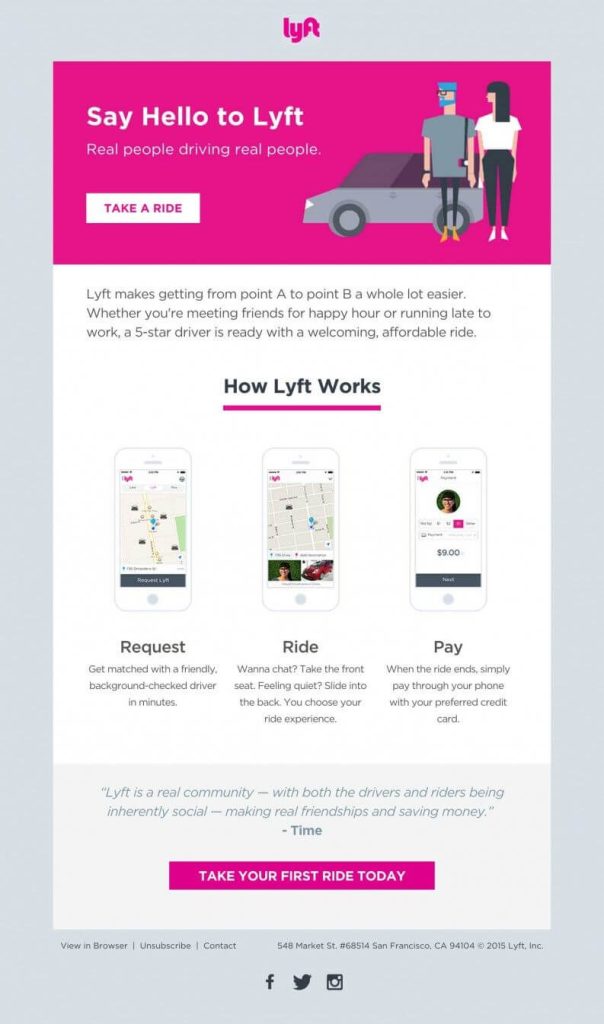
Image Source: Sender
Three tips for high-performing welcome sequences:
- Use Personalization: Address your email recipient by their name in the subject line or email content or share a personalized image or video welcoming them to your world;
- Ask a Relevant Question: Email replies are a form of engagement that can boost email deliverability. Incentivize them to reply by offering them an exclusive prize;
- Set the Right Expectations: Tell them what they can expect by staying on your email list and how frequently they will likely receive it.
Ensure your welcome emails are short, sweet, and more about the user than your brand.
2. Onboarding Campaigns
Onboarding drip campaigns are those where you’re trying to get your new customer or user activated by getting them to start using your product or service.
Use these emails to familiarize your users with what you are offering, its key features and benefits, the ways to access it, and tips on how to get the best out of their investment.
Grammarly’s easy-to-read onboarding campaign shows us how it is done:
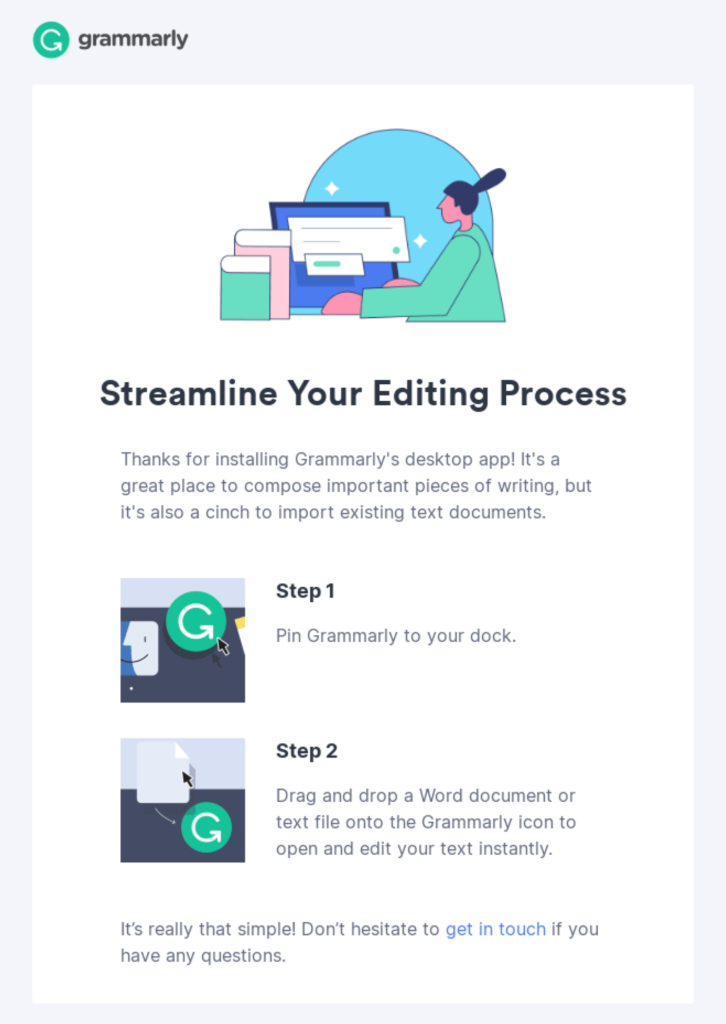
Image Source: Grammarly
Three tips for effective onboarding sequences:
- Go Micro: Break up large and complex steps into easily digestible micro-steps;
- Make It Visual: Use screengrabs, videos, tutorials, and whatnot to make it simpler for them to get unstuck and take action;
- Prioritize Quick Wins: Focus on encouraging micro-actions that can be accomplished quickly and yield tangible results and then celebrate these wins;
The whole idea of onboarding emails is to maximize the value your users can get out of your offering, thereby optimizing their likelihood of success.
3. Re-Engagement Campaigns
With a re engagement drip campaign, you target inactive subscribers on your email list. The idea is to rekindle the interest and affinity they showed for your business before and get them to engage with it.
Most email marketing software vendors count inactive subscribers as part of the total number of contacts. Secondly, these disengaged contacts also affect your email deliverability by not engaging with your emails.
GoDaddy’s re engagement campaign offers 30% OFF on new domain purchases to its older customers.

Image Source: GoDaddy
Three tips to win your former prospects & customers back:
- Craft Catchy Subject Lines: Use extreme curiosity, ultimate benefit, or outright shock to give your readers a compelling reason to open your emails;
- Work in Batches: Sending out all your re engagement emails at once can affect your inbox deliverability. So do it in smaller batches;
- Provide an Irresistible Benefit: Share a limited-time discount code, rare-to-find resource, or highly relevant content to get your target audience to change their mind in an instant;
If you run an ecommerce business, re engagement drip campaigns (often referred to as sunset sequences’) are especially popular. However, these are just as applicable for other forms of online engagement where you’re trying to revive an older business relationship.
4. Abandoned Cart Campaigns
An abandoned cart sequence is where you’re trying to recover lost sales by targeting users who added items to their online shopping carts but didn’t complete the checkout.
With abandonment rates ranging from 50% to 98%, abandoned shopping carts can be a considerable revenue leak for most industries.
Athletic wear brand Fabletics does a great job of combining simple messaging with a beautiful design below:
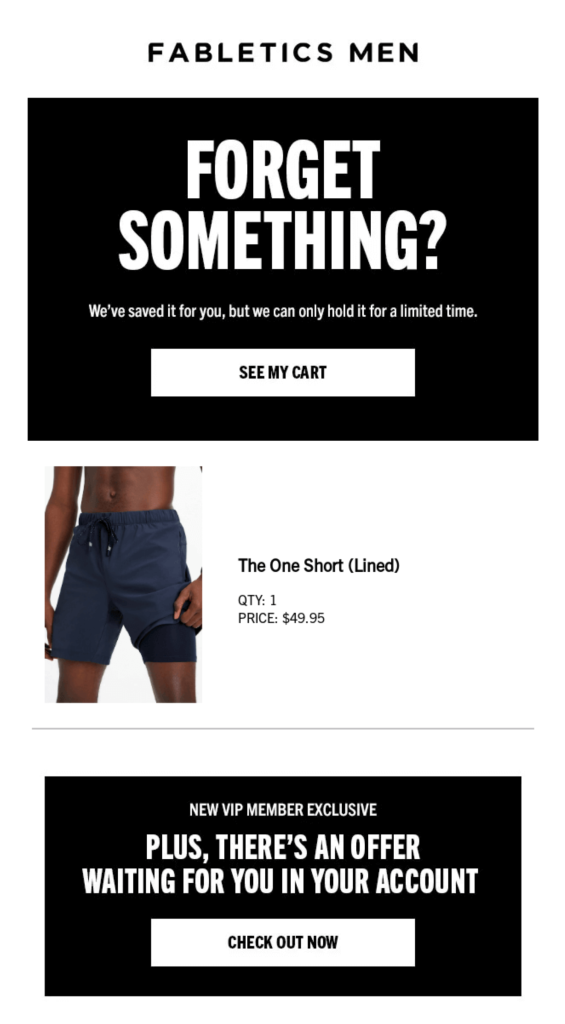
Image Source: Fabletics
Three tips for recovering lost sales through cart abandonment sequences:
- Remind Them Multiple Times: Send out multiple emails, spaced out at regular intervals, to remind customers to come back and complete the purchase;
- Add a Mouth-watering Incentive: Insert a limited-time BOGO, free shipping, or exclusive discount offer to get your prospect to take action immediately;
- Include Social Proof: Social proof in the form of user testimonials or user-generated content (UGC) can help, especially if it is specific to the abandoned product;
The abandoned cart campaigns are great examples of quick wins, especially if you run an online store, because they’re simple to set up and bring in lost sales for free.
5. Post-Purchase Campaigns
A post purchase email drip campaign nurtures and further monetizes your business’s relationship with its newest paying customers. This email sequence is sent right after the purchase to confirm purchase details, share shipping status, encourage repeat purchases, and more.
Bellroy’s post purchase feedback message below is one of those email drip campaign examples to remember. A simple design and highly persuasive copy make it a must-review for any user.
Three tips to improve your customer experience and get them to buy more:
- Make Them Feel Special: Express your appreciation for the purchase, and make them feel valued;
- Ask for Feedback: After a user has spent time with your product, you may want to ask them for their feedback;
- Cross Sell & Upsell: Based on their current buying behavior, recommend them related or better products that’re likely to add more value to their existing purchases;
Reaching out to your existing customers promptly tells them that you care. Do this meaningfully from time to time, and your customer relationships will go from strength to strength.
6. Nurturing Campaigns
Very few prospects buy at their first chance. Therefore, your business must use nurture drip campaigns to build, maintain, and progress relationships with leads.
Email nurturing campaigns provide educational or entertaining content over a long period as part of a drip feed. Use them to help shape the customer journey by leading your prospects through custom buying experiences.
Harry’s email below is an excellent example of a successful drip campaign that uses an infographic to gently entice the user into using the product.
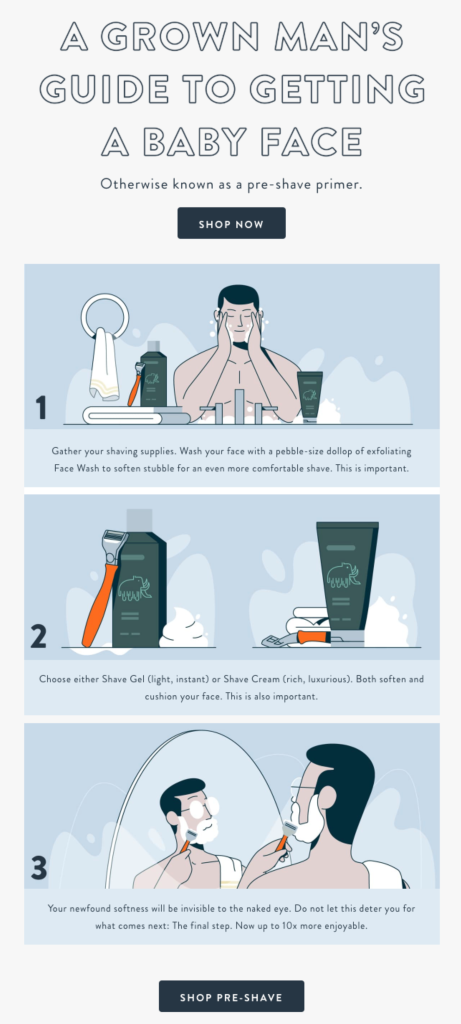
Image Source: Harry’s
Three tips for converting casual leads into highly interested, loyal fans:
- Always Segment Your Audience: Grouping the contacts in your email list by commonalities such as interests, demographics, preferences, and other factors can give you highly focused segments to target;
- Provide Actionable Tips: Include actionables in your email that help your readers solve their micro-problems. This will help you build trust with them;
- Include Calls to Action (CTA) in Most Emails: Just because it’s a value email doesn’t mean it won’t carry any links or buttons to click on. Include at least one link in your emails so your readers know where to go next.
When done correctly, a nurture email drip campaign can help you build credibility in the eyes of your audience also elevate your brand to a thought leader status.
7. Birthday or Anniversary Campaigns
Email campaigns for birthdays or anniversaries are sent out to subscribers on special occasions, such as their birthdays or the anniversary of their relationship with the company.
Use this email drip campaign to make subscribers feel special about the occasion. You can make it extra special by including an exclusive bonus, discount, or irresistible offer along with your messages.
Online language learning platform Busuu surprises its free users on the 3rd anniversary of their sign-up with an incredible discount.
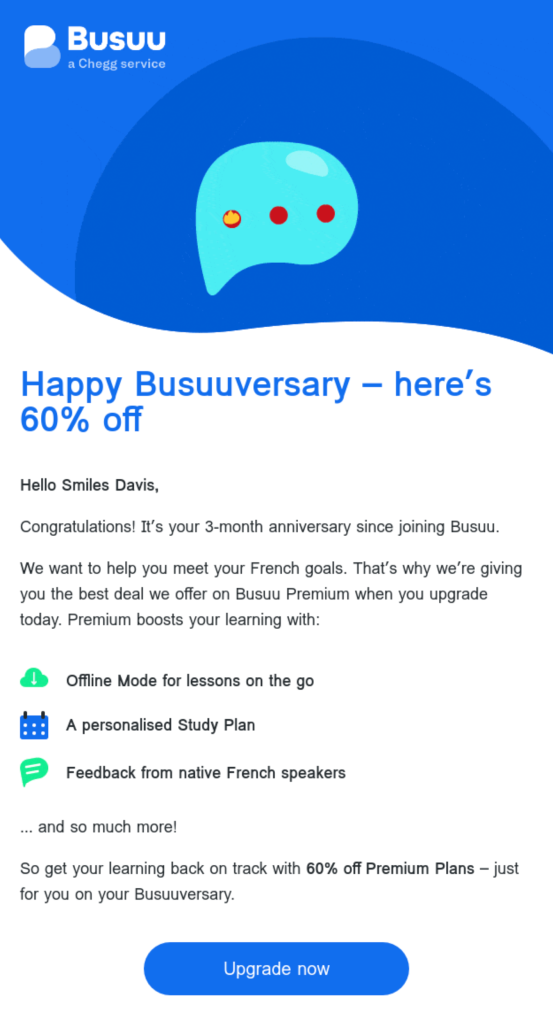
Image Source: Busuu
Three tips for leveraging special occasions and having prospects think only of you:
- Use Custom Fields in Signup Forms: Record your prospects’ purchase anniversary dates or collect their birthdates using custom fields;
- Offer Incentives for Referrals: Include a bonus for anyone who’d like to refer you over to their immediate contacts;
- Use Multiple Channels: Don’t restrict yourself to just emails. Go all out and send a birthday SMS, too, just for good measure.
Besides creating an attractive design, it also helps inject a sense of urgency by using a countdown timer to motivate users to take action before the offer expires.
Conclusion
Embracing email automation and implementing effective email drip campaign funnels can be a profit multiplier for your business. By nurturing leads, boosting engagement, and driving conversions on automation, you’re ready to unlock the next level of business growth.
These are three key takeaways to note:
- Relevance is King: To generate the best business results, tailor your message, content, and offer to your subscribers;
- Timing is Crucial: Plan your drip emails’ timing and frequency to ensure you are not underwhelming or overwhelming your subscribers. Make smart decisions using data-driven insights;
- Feel Free to Experiment: Avoid traditional emails and explore interactive, gamified options such as surveys, quizzes, and games. Engage your audience with immersive experiences, encourage participation, gather valuable insights, and foster stronger connections.
No drip campaign strategy is perfect, but the right ones will deliver value to your target audience while driving quantifiable business outcomes.

